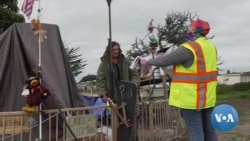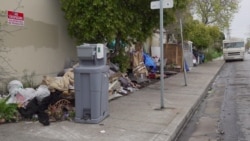Officials in cities and counties throughout California are struggling with how best to help more than 100,000 homeless residents during the COVID-19 pandemic.
But officials face multiple challenges tackling what has been an escalating crisis even before the coronavirus hit. The virus adds a new, deadly twist to the challenge:
Bring people into crowded homeless shelters and increase the risk of exposure to the virus.
Or leave them on the streets with limited access to sanitation, and the virus may spread quickly through encampments.
Shelter in convention centers, museums
Cities and counties are trying piecemeal approaches.
In Northern California, Oakland moved some sick homeless people into two vacant hotels, and the city is setting up 60 emergency Federal Emergency Management Agency trailers to shelter the most vulnerable homeless residents, and another six more for homeless young people.
San Jose has converted two convention centers to house the homeless — with cots the recommended distance apart — and has committed to spending $17 million on prefab tiny homes.
This week, San Francisco officials said it would lease 7,000 hotel rooms for both homeless people and first responders, tripling the number of hotel rooms it currently has contracted. The city is also tapping space in closed museums.
California Gov. Gavin Newsom, in a news conference this week, said the state, with help from the federal government, is working to secure 15,000 hotel rooms to shelter the state’s homeless through the pandemic.
“There’s not a state in America that’s even put a plan together to get 15,000 rooms,” he said. “And I’m very proud of those efforts.”
Setting up sanitation stations
Homeless people on California streets and in shelters have tested positive for the coronavirus. Instead of waiting for official plans to kick into action, volunteers and homeless outreach workers have been going to encampments to urge people to spread out their tents. They are giving out masks and food and setting up handwashing stations.
Joe Pendleton is an Army veteran who lives in Berkeley in his tricked-out van with his dog, Griz. He’s doing better than most: He has a stove, a refrigerator, a freezer and a laptop.
Pendleton works with volunteers from the Berkeley Free Clinic and other organizations to prepare the homeless encampments for the pandemic. They’ve done their own informal census of who lives in which camps, doorways and alleyways so that they can keep track of them in case people get sick.
Nowhere to charge phones, use a bathroom
“We've come up with our own system of moving people through camps if we suspect they're sick, so they're quarantined from everybody else,” Pendleton said. “We're homeless, not helpless.”
But this is a vulnerable population with limited access to services and information.
Some are unaware of the pandemic, said Yesica Prado, an out-of-work Lyft driver and freelance journalist who lives in a recreational vehicle in Berkeley. When the shelter-in-place orders began and businesses closed, homeless people lost places where they could routinely use the bathroom, charge their phones and buy food, she said.
“So if anything, we have spread information within ourselves,” she said. “You know, make sure that our neighbors know what's going on.”
A permanent solution?
While most officials are scrambling to come up with a plan for the next weeks and months, Oakland Mayor Libby Schaaf is hoping the crisis may be an opportunity to address the problem of homelessness in her city.
“We really don’t want to have a situation where when the pandemic is over and we’re kicking people back out onto the street,” she said. “We want to be strategic in this moment and do things now in the face of this emergency that can serve us in the long term.”
Whether those plans ever come to fruition remains to be seen. For now, officials are in a race against the clock to set into motion their homeless plan before the expected surge in COVID-19 cases hits.












